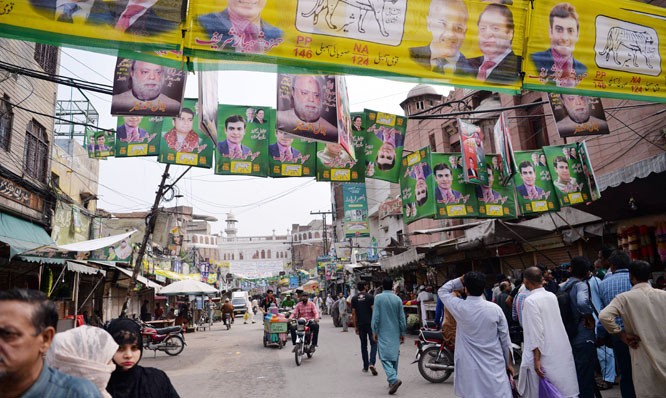

‘Art’ is on display all over during the election campaign. We have posters, banners, commercials, flexes, buntings -- all advertising the reasons why the electorate should vote for a certain candidate or a party. We have slogans, captions and then we have jingles or songs that through compositions make short work of all the preaching or sermonising that may have taken place otherwise. The images of the leaders are plastered and visual motifs in text or images spread to convey a certain message or a signal to win the hearts and minds, and hence votes.
Is it art or is it the use of various constituents or elements that make art? Or, in other words, it is the throwback to an archetypal debate: whether art is there for its own sake or is it just a vehicle for promoting or propagating another set of values that lie outside of it?
Two areas that have used parts or constituents of art to a great degree have been religion and politics. Though the conventional understanding of religion in our part of the world condemns the use of sur, or image, yet most of the religious establishments now use the visual media as well as rendition as an indispensable means of attracting attention to itself or the message that there may be. And, to top it all, these compositions are usually those that have become popular as a film number. Just by changing the lyrics and by fixing a few words, the composition is supposedly reinvented for promoting religious piety.
Similarly in politics visual images, slogans and jingles are spread far and wide to build the cult of personality. The great leader has arrived and he is the deliverer ridding humankind of all ailments; posited as the saviour, he is the only one with charisma to uplift humanity out of the state of despair, backwardness and now corruption.
These days, of course, it is the digital media that has been used unabashedly -- for either the promotion of a certain person or a slandering circulated in an instant all over. But while the image or a composition has to be managed in some manner of aesthetics, the text has to be packed with slander and sensation to the full.
Language too has had its problems in this part of the world. Quaid-e-Azam could just utter a few doctored sentences of Urdu that he declared as the national language of the country he founded. He felt at home in English even while delivering public speeches to people who hardly knew the language. Has anyone bothered to find out what his mother tongue was -- Gujarati or some variant of Kachi Sindhi? The Bengalis pronounced certain Urdu words in their own manner, sounding literally like abuses. Then Zulfikar Ali Bhutto invaded the field and his demolition of Urdu language seemed like music, forgiven and condoned. And these days it is Imran Khan who stresses that Iqbal "ney Pakistan ki khawab dekhi" and Bilawal who transforms magically when he switches from a struggling acquired pidgin dialect he calls Urdu to English.
We know that the Pashtuns have a problem with genders but so do Punjabis and perhaps Sindhis. It is time to say goodbye to the remnants of purity of language, Urdu-e-Muallah, ride the bandwagon of an evolving idiom and build a vocabulary and structure of Urdu that is more in synch with the local languages spoken here.
In modern times or postmodern times, when art has been hugely displaced from its hallowed pedestal, the right to call art or to label it as such has become the prerogative of the viewer, reader or the listener. The key to it all has been unceremoniously transferred to someone who consumes it rather than who creates it. So, the definitions have all become fluid and move unashamedly from one to the other -- prose to poetry, formalism to abstraction, rapping to tunelessness.
There has been an aversion to art when it exists for its own sake, rather than for another purpose more realisable and tangible like the promotion of religious values, or some political good like alleviating poverty. Is the inflection of a debate, whether pure thought or speculation, for its own sake that has any value or should it be preferred to be directed to an end that is realisable?
Thinking for its own sake has been branded as a luxury, and art for the sake of art as indulgence. It is made to be a negative act that is not supposed to be of service of any kind. But it may be stressed that the most profound thinking patterns and artistic creation may not be the consequence of finding a solution but of wallowing in the process itself. Perhaps people are not ready as yet for such adequate activity, and seek crutches of tangible and realisable goals.
In this election campaign, all these elements are used and no one questions them. But you utter a word about the autonomy of art and all hell will be let loose. All kinds of objection and opinions will be dug to denounce or condemn in advancing the argument. The whole is lost or in veil from its parts; this has been the tragedy that is not addressed and can’t be, especially during an election.